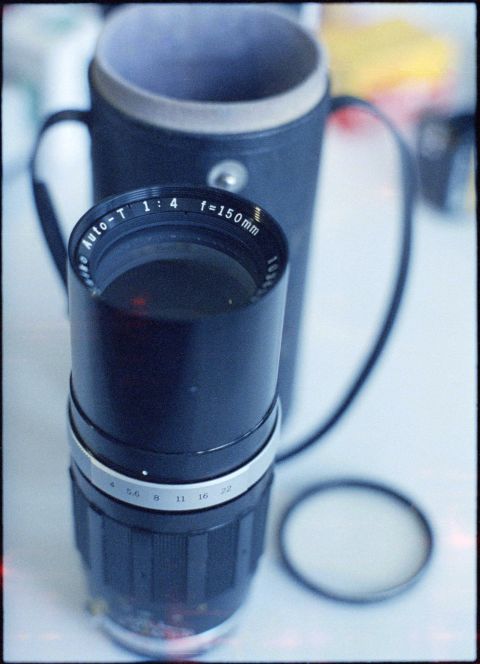Olympus 150mm 1:4 E.Zuiko Auto-T Lens Review
A Half-Frame Telephoto
7 min read by Dmitri.Published on . Updated on .
The 150mm Olympus E.Zuiko Auto-T is one of the longest lenses ever made for a half-frame film camera. Though not the longest, its focal length approximates to about 210mm on a full-frame camera, which is approaching the super-telephoto territory.
Built for the Olympus PEN F camera series, this lens is a much more compact variant of what you’d have to mount on a full-frame 35mm film camera. The PEN system was built in the 1970s, long before digital cameras were even considered for mass production. Back then, the half-frame format was mostly used as a dollar-saving tool; 35mm film was considered a small format, while the medium and large formats were a common choice of the pros. But Yoshihisa Maitani had a vision, which is a continuously improving resolution of a modern emulsion.
Yoshihisa was right; modern films like Provia 100F and Ektachrome E100 may easily produce 40MP+ scans off 35mm with a good scanner. Eventually, the digital revolution brought on sensors that can pick up even smaller detail on a half-frame footprint, but the modern lenses aren’t the same. Many pack heavy, battery-hungry autofocus systems and the majority are housed in janky-looking plastic shells.
Recommendation pending…In this review: Lens size, weight, and specifications. Image quality. Lens build quality, handling, and ergonomics. Where to buy your F.Zuiko Auto-T 70mm lens. Support this blog & get premium features with GOLD memberships!
Lens size, weight, and specifications.
150mm E.Zuiko Auto-T is a manual focus lens housed in black brass and aluminum chassis. A silver aluminum ring controls its aperture between 𝒇4 and 𝒇22 with full-stop clicks. I have an older lens version — a newer aperture control can be lifted and turned around to reveal exposure numbers used by the PEN FT light meter system.
The lens has a 180° focus throw with depth of field markings, including an IR focus shift line.
The silver ring at its base houses the lens mount lock button and aperture preview button.
The entire thing weighs 354g/12½oz and measures 15×4cm (5.9×1.57”). And it often comes with a carrying case.
Image quality.
Olympus E.Zuiko Auto-T can show some slight softness across the frame; however, it’s hard to say if it’s the lens or the air density stacking up over long distances. For best results, most images could benefit from slight sharpening in post. Other than that, I would consider picking high-resolution films with your PEN FV to keep the maximum detail in your half-frames.
The lens can flare, although I haven’t found that to be a problem with any of the images I’ve been making with it. It has a good contrast level and no barrel distortion — an advantage of a long focal length. As you may notice from some of the samples below, even at 𝒇4 (or smaller), the lens produces noticeable, pleasing bokeh.
Overall, Olympus E.Zuiko Auto-T is a very fun lens to use. It’s compact, usable hand-held, and, as you should see from the variety of shots posted in this review, capable of making sharp, well-defined exposures that you can print reasonably large.
Above: Photos taken with my Olympus E.Zuiko Auto-T on CineStill 50D, Lomochrome Purple, and Velvia 50.
Lens build quality, handling, and ergonomics.
The trick with shooting long focal length lenses is camera shake that’s a lot more apparent than with normal or wide-angle lenses. Anything slower than 1/250s is very difficult to keep still while hand-held. Though there are longer lenses available for the Olympus PEN system, this F.Zuiko Auto-T reaches an excellent balance of focal length, size/weight, and usability without a tripod.
The lens feels solid in hand without a burdensome weight factor. However, its focus threads would typically benefit from some service as, over the years, the lubricants may become sticky and a little heavy to turn. The aperture ring’s clicks may also become barely perceptible as they tend to wear out, and the front half may appear loose — although none of these issues appear to have any effect on the image quality. The only thing I’d consider paying particular attention to is its aperture rings: the depth of field preview button may reveal that they could have trouble returning to their open position — a common issue on the PEN F series.
F.Zuiko Auto-T stops short of being an excellent quality build. It certainly does not feel cheap though it’s not a Leica glass. I would certainly not hold that against the lens, however. Better yet, the way it’s put together makes it relatively easy to disassemble and service.
The case that comes with the lens isn’t particularly fancy, but it does the job. I certainly recommend picking a copy that has one for easy packing and transportation.
Where to buy your F.Zuiko Auto-T 70mm lens.
Most of these lenses are sold on eBay by Japanese retailers. As of this writing, they aren’t very expensive, ranging from $150 to $250. As with any other glass, I recommend paying particular attention to photographs and asking questions — most importantly about the aperture blades. Though if you have some experience taking lenses apart, cleaning the elements shouldn’t be too difficult — as long as there’s no balsam separation, you should be in good shape.
❤ By the way: Please consider making your 150mm Olympus E.Zuiko Auto-T purchase using this link so that this website may get a small percentage of that sale — at no extra charge for you — thanks!
